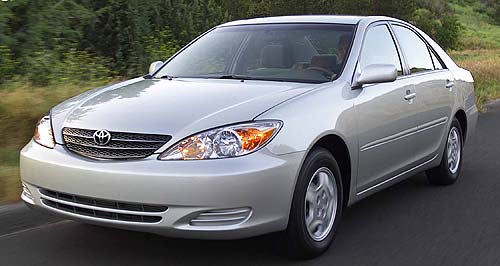Make / Model Search
News - ToyotaToyota throttle cleared of acceleration glitchCleared: the Toyota Sienna was one of the carmakers' US lineup to be rcalled. NASA engineers give Toyota’s electronic throttle the all-clear in US safety probe9 Feb 2011 UNITED States road safety authorities have given Toyota’s electronic throttle system a clean bill of health after an unprecedented 10-month investigation into claims of unintended acceleration on American roads. The US National Highway Traffic Safety Administration (NHTSA) enlisted engineers from the National Space and Aeronautical Administration (NASA) in the investigation into the potential for electrical interference or software glitches as a potential cause for the problem. Sticking throttle pedals and moving floor mats that could entrap accelerator pedals remain the only known safety defects to cause unintended acceleration in Toyota’s range of cars and light-trucks in the US, where Toyota recalled eight million vehicles to address the issues. Globally, Toyota has recalled 18 million vehicles since 2009. So far, Toyota has paid $US48.8 million in fines to US authorities, and also is still facing a number of lawsuits. As a bonus of the NHTSA investigation, NASA has come up with a range of suggestions on how to make cars safer, using techniques from the aeronautical and space industries. NHTSA has promised to consider the proposals, which include robust fail-safe systems that can protect against ‘two-fault’ problems and diagnostic codes that can convey safety-critical information to drivers.  Left: US transportation secretary Ray LaHood. Left: US transportation secretary Ray LaHood.More immediately, it is proposing new rules by the end of this year to require brake override systems, to standardise the operation of keyless ignition systems and mandatory aircraft-style ‘black box’ event data recorders. Announcing the findings of the NHTSA investigation last night, US transportation secretary Ray LaHood said: “We enlisted the best and brightest engineers to study Toyota’s electronics systems, and the verdict is in. “There is no electronic-based cause for unintended high-speed acceleration in Toyotas."Toyota’s chief quality officer for North America Steve St Angelo said Toyota welcomed the findings and appreciated the thoroughness of the review into the electronic throttle system, which Toyota calls ETCS-i. “We believe this rigorous scientific analysis by some of America's foremost engineers should further reinforce confidence in the safety of Toyota and Lexus vehicles,” he said. “We hope this important study will help put to rest unsupported speculation about Toyota's ETCS-i, which is well-designed and well-tested to ensure that a real world, un-commanded acceleration of the vehicle cannot occur. “We will continue to develop and equip Toyota and Lexus vehicles with industry-leading safety technologies, including many based on breakthroughs in sophisticated electronics systems. “We will also continue to cooperate fully with NHTSA and respected outside experts in order to help ensure that our customers have the utmost confidence in the safety and reliability of our vehicles.” In their research, NASA engineers evaluated the electronic circuitry in Toyota vehicles and analysed more than 280,000 lines of software code for any potential flaws that could initiate an unintended acceleration incident. At the Goddard Space Flight Centre in Maryland, NASA hardware and systems engineers tested mechanical components , while in Michigan, NHTSA and NASA engineers bombarded vehicles with electromagnetic radiation to study if such radiation could cause malfunctions resulting in unintended acceleration. NHTSA engineers and researchers also tested Toyota vehicles at NHTSA’s Vehicle Research and Test Centre in Ohio to look for any additional mechanical causes for unintended acceleration and whether any of the test scenarios developed during the NHTSA-NASA investigation could occur in real-world conditions. NASA Engineering and Safety Centre (NESC) principal engineer Michael Kirsch said: "NASA found no evidence that a malfunction in electronics caused large unintended accelerations."One of the first concrete results of the investigation will be a new design rule to require brake override systems in all passenger vehicles to ensure that braking takes precedence over the accelerator pedal in emergency situations. Toyota has already introduced such a system, called Smart Stop Technology, as standard equipment on all the new vehicles for the North American market. As well, NHTSA is researching pedal placement to see if certain designs can help to avoid pedal misapplication, which it says happens in vehicles across the industry.  Read more |
Click to shareToyota articlesResearch Toyota Motor industry news |












Facebook Twitter Instagram